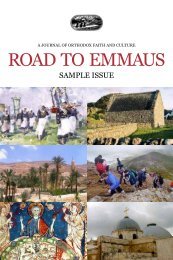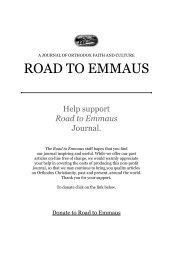St. Ephraim of Nea Makri - Road to Emmaus Journal
St. Ephraim of Nea Makri - Road to Emmaus Journal
St. Ephraim of Nea Makri - Road to Emmaus Journal
Create successful ePaper yourself
Turn your PDF publications into a flip-book with our unique Google optimized e-Paper software.
32 <strong>Road</strong> <strong>to</strong> <strong>Emmaus</strong> Vol. 2.1 (4)<br />
asked him <strong>to</strong> dig in hope <strong>of</strong> finding the original monastery well. He refused,<br />
saying there were other places where he was more likely <strong>to</strong> find water, and for<br />
several hours he dug in different locations without success. That afternoon he<br />
returned <strong>to</strong> the courtyard <strong>to</strong> dig in the spot Sister Macrina had indicated.<br />
They quickly uncovered a fireplace, three small windows, and a partially<br />
ruined wall—indications that the site had once been the cell <strong>of</strong> a monk. As<br />
Sister Macrina and the worker cleared away the rocks, he dug so energetically<br />
that she became fearful that he might damage something holy and begged<br />
him not <strong>to</strong> rush. He wouldn’t listen until finally she said, “Perhaps there is<br />
someone buried in these ruins and you might strike his remains; I beg you <strong>to</strong><br />
be careful.” He looked at her in surprise and said, “Do you really believe you<br />
are going <strong>to</strong> find someone buried here?” Sister Macrina recounts:<br />
I was very sure, and I could almost visualize the monk. We continued<br />
the holy work <strong>of</strong> digging, and at one hundred seventy centimeters<br />
[about five and a half feet] we first glimpsed the head <strong>of</strong> the monk <strong>of</strong><br />
God. As we uncovered it, a wonderfully fragrant smell surrounded<br />
us. The worker was pale—he couldn’t speak. I asked him <strong>to</strong> leave me<br />
alone and he departed. With great devotion I kissed the Saint’s relics<br />
and felt deeply that he had endured some mysterious <strong>to</strong>rment. I was<br />
filled with holy joy—as if I had acquired a divine treasure.<br />
I had felt that he was a monk, and then, as I gently moved the<br />
sand away I saw the hem <strong>of</strong> his<br />
cassock still intact. The fabric<br />
was clean and intricately worked<br />
on an old-fashioned loom—the<br />
threads were larger than a millimeter<br />
in thickness. When he was<br />
buried the ground had hardened<br />
around his hands and feet, and<br />
the prints were still there... I<br />
tried <strong>to</strong> clean the mud from the<br />
bones <strong>of</strong> his fingers but they<br />
were so fragile that they began<br />
<strong>to</strong> crumble. It began <strong>to</strong> rain and<br />
the water moistened the grave<br />
so quickly that I left the relics<br />
as they were <strong>to</strong> allow the rain,<br />
which had been falling gently,<br />
like little silver leaves, <strong>to</strong> cleanse<br />
the Saint and his grave.<br />
New Martyr <strong>Ephraim</strong> <strong>of</strong> <strong>Nea</strong> <strong>Makri</strong> 33<br />
Later that evening as I was reading the Vespers Service, alone in<br />
this holy place where God had led me, I suddenly heard footsteps approaching<br />
the church from the side <strong>of</strong> the courtyard where the grave<br />
was. I knew it was him, the unknown Saint. His steps echoed in my<br />
ears and I was tremendously frightened. The blood rushed <strong>to</strong> my<br />
head and I felt numb, unable <strong>to</strong> even turn around. Suddenly behind<br />
me I heard a voice asking quietly, “How long do you intend <strong>to</strong> keep<br />
me out there?” I turned and looked. He was tall with dark hair and<br />
had round, heavy-lidded eyes. His black, curly beard amply covered<br />
his neck. In his left hand was a bright light and with his right hand<br />
he blessed me.<br />
With his words, my fear vanished, and in its place was an overwhelming<br />
joy as if I was again meeting someone I knew well. I said<br />
<strong>to</strong> him, “Forgive me, <strong>to</strong>morrow at dawn I will take care <strong>of</strong> your holy<br />
relics.” He faded from my sight and I continued <strong>to</strong> read the evening<br />
service...<br />
In the morning, I reverently cleaned the mud from his relics, and<br />
then washed and placed them in the church where I lit a lampada.<br />
That night I dreamt I saw the monk again, standing inside the church,<br />
holding in his arms a large, beautifully-worked silver icon. Next <strong>to</strong><br />
the icon was a candle holder, where I lit a large beeswax candle and<br />
heard him say, “Thank you very much. I am <strong>Ephraim</strong>.” 1<br />
Over the next few years in visions and dreams, <strong>St</strong>. <strong>Ephraim</strong> <strong>to</strong>ld Sister<br />
Macrina and others the s<strong>to</strong>ry <strong>of</strong> his martyrdom.<br />
Born on the 14th <strong>of</strong> September, 1384, the Saint lost his father when he<br />
was a young child, and he and his six brothers and sisters were raised by his<br />
pious mother. At fourteen, <strong>St</strong>. <strong>Ephraim</strong> went <strong>to</strong> the Monastery <strong>of</strong> the Annunciation<br />
<strong>of</strong> the Mother <strong>of</strong> God, where he lived in prayer and asceticism for<br />
twenty-seven years. He was granted the grace <strong>of</strong> the priesthood and became<br />
guardian <strong>of</strong> the monastery. It is unknown whether he was alone or if there<br />
were other monks there as well.<br />
On his birthday in September <strong>of</strong> 1425, the Feast-day <strong>of</strong> the Exaltation <strong>of</strong><br />
the Cross, Fr. <strong>Ephraim</strong> was taken captive by Islamic pirates and <strong>to</strong>rtured, his<br />
cap<strong>to</strong>rs insisting that he deny Christ. He refused and his <strong>to</strong>rment lasted for<br />
eight months, his cap<strong>to</strong>rs allowing his wounds <strong>to</strong> heal a little and then <strong>to</strong>rturing<br />
him anew. On May 5, 1426, he was taken out in<strong>to</strong> the courtyard and hung<br />
upside down from a tree that is still <strong>to</strong> be seen at the monastery. Nails were<br />
1 Paraphrased from The Miracles and Sightings <strong>of</strong> The Miraculous and Great-Martyr Saint<br />
Efraim, the Newly Revealed (1384-1426), Vol. II, Holy Monastery <strong>of</strong> the Annunciation,<br />
1994, and verifi ed in 1995 interview with Abbess Macrina.










